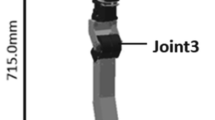Abstract
With technology advancements in computers and displays, computer interfaces can be used to alleviate the operator workload while controlling a complex robot. A graphical simulation of the robotic system can be used to improve development, train operators, and enhance their performance during actual operations. This paper summarizes the advantages realized using a graphical simulation to visually display telemetry from a multiple arm space telerobot. By displaying the commanded position of a manipulator graphically along with the actual position, the operator becomes more effective in diagnosing anomalies in the system. The negative impact of communication time delay can also be alleviated using this commanded display. The above advantages coupled with the simulation's ability to display multiple synthetic views, to move each view to any virtual location, and to highlight functions to emphasize important information, can ease the operator's workload, making him or her more effective in controlling a complex system.
Similar content being viewed by others
Explore related subjects
Discover the latest articles, news and stories from top researchers in related subjects.References
Backes, P. 1994. Supervised Autonomy for Space Telerobotics, American Institute of Aeronautics and Astronautics, Inc.: Washington, DC.
Black, J. 1971. Factorial study of remote manipulation with transmission time delay. M.S. Thesis, MIT.
Bejczy, A. and Kim, W. 1990. Predictive displays and shared compliance control for time-delayed manipulation. In Proceedings IEEE International Workshop on Intelligent Robots Systems, IROS.
Ferrell, W. 1965. Remote manipulation with transmission delay. IEEE Transactions in Human Factors in Electronics, 6(1):24–32.
Hirzinger, G., Brunner, B., Ditrich, J., and Heindl, J. 1994.ROTEX—The first remotely controlled robot in space. In Proceedings of the IEEE Conference on Robotics and Automation.
Kelley, C. 1962. Predictor instruments look into the future. Control Engineering, 9(3):86–92.
Lane, J. 2000. Human factors optimization of virtual environment attributes for a space telerobotic control station. Diss. Univ. of Maryland, College Park.
Mar, L. 1985. Human control performance in operation of a time-delayed master-slave telemanipulator. B.S. Thesis, MIT.
Noyes, M. 1982. Superposition of graphics on low bit rate video as an aid in teleoperation. M.S. Thesis, MIT.
Thompson, D. 1977. The development of a six degree of freedom robot evaluation test. In Proceedings of 13th Annual Conference Manual Control, MIT, Cambridge, MA.
Author information
Authors and Affiliations
Rights and permissions
About this article
Cite this article
Lane, J.C., Carignan, C.R. & Akin, D.L. Advanced Operator Interface Design for Complex Space Telerobots. Autonomous Robots 11, 49–58 (2001). https://doi.org/10.1023/A:1011256128651
Issue Date:
DOI: https://doi.org/10.1023/A:1011256128651




